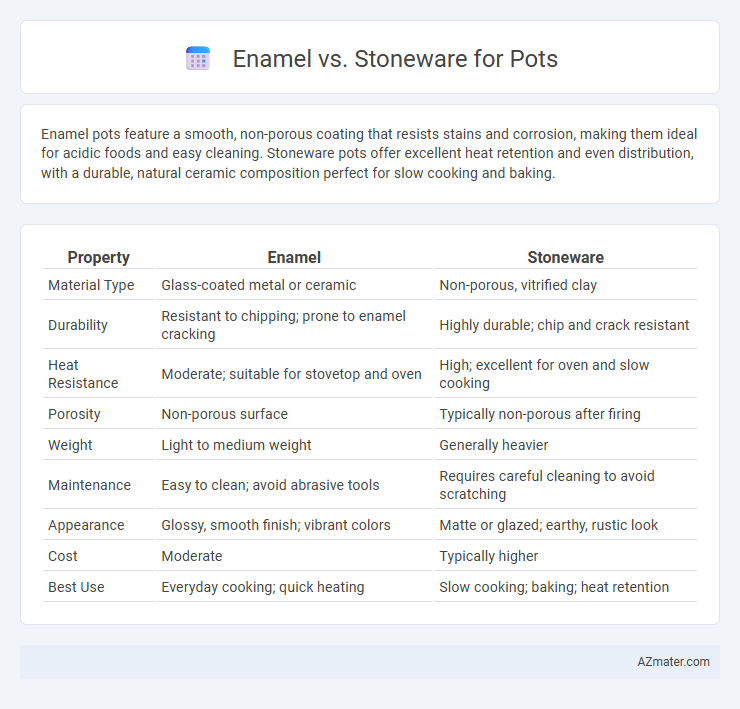Enamel pots feature a smooth, non-porous coating that resists stains and corrosion, making them ideal for acidic foods and easy cleaning. Stoneware pots offer excellent heat retention and even distribution, with a durable, natural ceramic composition perfect for slow cooking and baking.
Table of Comparison
| Property | Enamel | Stoneware |
|---|---|---|
| Material Type | Glass-coated metal or ceramic | Non-porous, vitrified clay |
| Durability | Resistant to chipping; prone to enamel cracking | Highly durable; chip and crack resistant |
| Heat Resistance | Moderate; suitable for stovetop and oven | High; excellent for oven and slow cooking |
| Porosity | Non-porous surface | Typically non-porous after firing |
| Weight | Light to medium weight | Generally heavier |
| Maintenance | Easy to clean; avoid abrasive tools | Requires careful cleaning to avoid scratching |
| Appearance | Glossy, smooth finish; vibrant colors | Matte or glazed; earthy, rustic look |
| Cost | Moderate | Typically higher |
| Best Use | Everyday cooking; quick heating | Slow cooking; baking; heat retention |
Introduction: Enamel vs Stoneware Pots
Enamel pots feature a smooth, glossy coating made from fused powdered glass, offering resistance to rust and easy cleaning, while stoneware pots are crafted from dense, non-porous clay fired at high temperatures, known for durability and natural heat retention. Enamel cookware excels in even heat distribution and vibrant color options, contrasting with stoneware's superior capacity to maintain consistent cooking temperatures and its rustic aesthetic. Choosing between enamel and stoneware pots depends on cooking style preferences, durability requirements, and maintenance considerations.
Material Composition and Manufacturing
Enamel pots consist of a metal base, typically steel or cast iron, coated with a layer of vitreous enamel made from powdered glass fused at high temperatures, providing a durable, non-reactive surface. Stoneware pots are crafted from dense, non-porous clay fired at temperatures between 1200-1300degC, resulting in a sturdy ceramic with excellent heat retention and resistance to thermal shock. The manufacturing of enamel pots involves metal shaping followed by enamel coating, while stoneware undergoes molding and kiln firing, reflecting distinct material properties that influence cooking performance and care requirements.
Durability: Which Lasts Longer?
Enamel pots feature a durable, chip-resistant coating that withstands high heat and resists stains and rust, making them ideal for long-term use in busy kitchens. Stoneware pots, while sturdy and resistant to thermal shock, are more prone to chipping and cracking under rough handling, which can affect their longevity. Overall, enamel pots generally last longer due to their robust, non-porous surface that maintains integrity despite frequent use and cleaning.
Heat Retention and Distribution
Enamel pots offer moderate heat retention with an outer layer of enamel fused to metal, allowing for quick heat distribution but less insulation compared to stoneware. Stoneware pots excel in heat retention due to their dense ceramic construction, providing even and consistent heat distribution ideal for slow cooking. Choosing between enamel and stoneware depends on cooking style, with enamel suited for rapid heating and stoneware favored for prolonged heat maintenance.
Cooking Versatility and Applications
Enamel pots offer superior non-reactive surfaces ideal for cooking acidic foods like tomato sauces, maintaining flavors without metallic taste, and are compatible with various heat sources, including induction. Stoneware pots provide excellent heat retention, making them perfect for slow-cooking, baking, and roasting applications, although they may be less suitable for high-temperature stovetop use. Both materials excel in oven safety, but enamel's durability and versatility make it more adaptable for diverse cooking techniques and frequent temperature changes.
Maintenance and Cleaning Requirements
Enamel pots feature a smooth, non-porous surface that resists staining and is easy to clean with mild soap and water, requiring no special maintenance to prevent rusting. Stoneware pots, while offering excellent heat retention, are porous and can absorb oils and odors, demanding careful hand washing and occasional seasoning to maintain their integrity. Avoid abrasive cleaners on enamel to prevent chipping, and ensure stoneware is completely dry before storage to prevent mold and cracking.
Safety: Non-Toxicity and Reactivity
Enamel cookware features a non-toxic, glass-like coating that prevents food from reacting with the metal base, ensuring safe cooking without leaching harmful substances. Stoneware pots are naturally non-reactive and free of harmful chemicals, making them a safe choice for acidic or alkaline foods. Both materials provide safe, chemical-free cooking surfaces suitable for health-conscious users.
Aesthetic Appeal and Design Options
Enamel pots offer a glossy, vibrant finish available in a wide spectrum of colors and patterns, making them ideal for those seeking bold and retro aesthetic appeal. Stoneware pots provide a natural, earthy texture with muted tones and handcrafted designs that appeal to fans of rustic and artisanal kitchenware. While enamel emphasizes bright, smooth surfaces and vintage styles, stoneware highlights organic textures and timeless, cozy aesthetics.
Price Comparison and Value for Money
Enamel pots generally cost less upfront than stoneware, with prices ranging from $20 to $60 compared to stoneware's $40 to $100 or more. Enamel cookware offers affordable durability and vibrant designs but may chip over time, whereas stoneware provides superior heat retention and longevity, often justifying its higher price through consistent cooking performance. For budget-conscious buyers seeking long-term value, investing in quality stoneware can result in better overall cost-effectiveness despite the initial premium.
Conclusion: Which Pot is Right for You?
Enamel pots offer a non-reactive, easy-to-clean surface ideal for acidic dishes and everyday cooking, while stoneware excels in heat retention and even cooking, making it perfect for slow-cooked meals and baking. Choosing between enamel and stoneware depends on your cooking style: enamel suits quick, versatile stovetop use, whereas stoneware is best for oven use and serving. Consider factors like heat distribution, maintenance, and intended use to select the pot that matches your culinary needs.

Infographic: Enamel vs Stoneware for Pot
 azmater.com
azmater.com